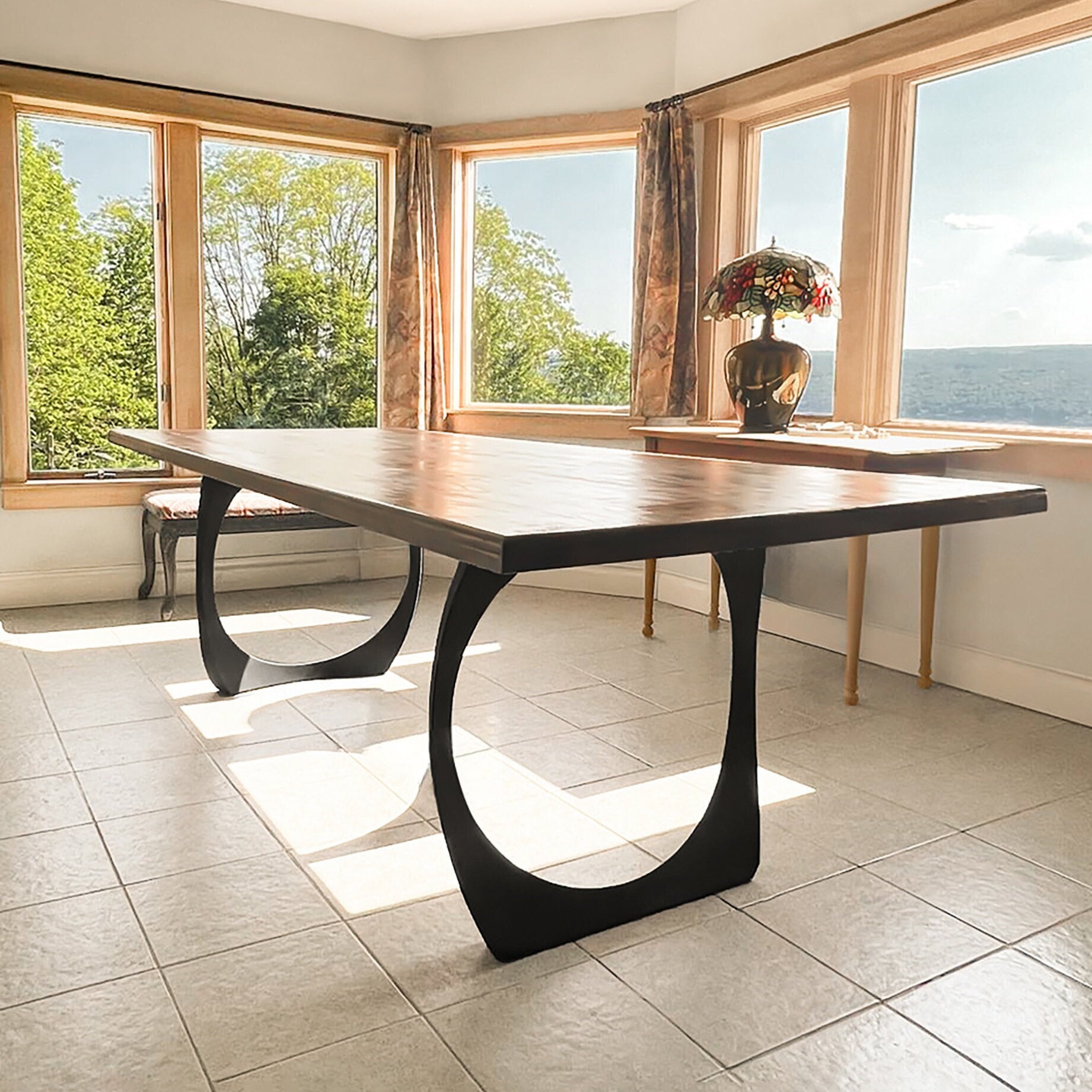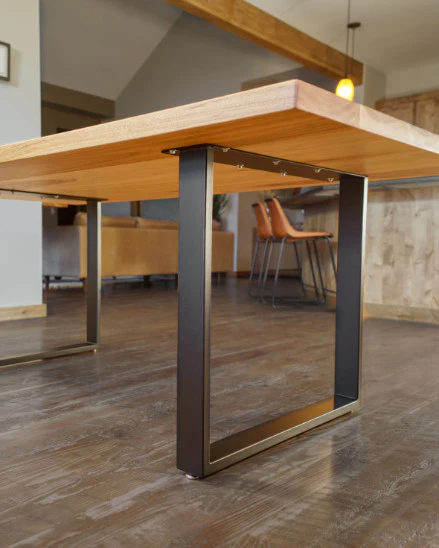Dining Room Table Legs That Integrate Performance and Modern Style
Dining Room Table Legs That Integrate Performance and Modern Style
Blog Article
Selecting the Perfect Table: What Styles Work Best for Your Home?
Picking the excellent table for your home can be a nuanced process that stabilizes appearances and capability. Whether your room leans towards traditional sophistication, modern minimalism, rustic beauty, or industrial elegant, the range of designs offered can accommodate diverse tastes. Each design supplies distinct benefits and challenges that can either improve or interrupt your dining location's harmony. Comprehending just how different products, shapes, and dimensions interact with your existing decoration is crucial. To browse these selections efficiently and find a table that absolutely complements your home, take into consideration the following elements carefully.
Assessing Your Space
Examining the dimensions and design of your dining area is a crucial primary step in selecting the perfect dining table. Begin by determining the size and size of the area, accounting for doorways, windows, and other architectural functions that can affect table positioning. This makes certain that your table not just fits but also permits comfortable movement around it.
Take into consideration the variety of individuals you commonly delight. A table should accommodate your household's daily needs while offering sufficient flexibility for occasional guests. As a rule of thumb, allocate at the very least 24 inches of table width per person to make sure a comfortable dining experience.
It's also vital to maintain appropriate clearance around the table. Ideally, there ought to be at least 36 inches in between the table side and walls or other furnishings, allowing simple gain access to and motion. For spaces where chairs with arms or added storage space systems like buffets are involved, raising this clearance to 48 inches is suggested.
Lighting and ambience play substantial functions as well. Make sure that your table straightens with existing lighting components or plan for adequate lights options. This thorough spatial evaluation assurances that your table not only fits physically however also balances with your space's overall capability and aesthetic.
Popular Table Styles

Standard eating tables often feature luxuriant information, bent legs, and abundant wood finishes, stimulating a feeling of classic beauty. They are excellent for homes with timeless decoration or those seeking to add a touch of elegance to their eating area.
Modern eating tables focus on simplicity and clean lines, frequently incorporating products like glass and metal. These tables are suitable for contemporary spaces, providing a streamlined and clean look that complements minimalist design ideologies.
Rustic table, on the other hand, emphasize all-natural materials and a handmade look - dining room table legs. They frequently feature redeemed wood and a distressed coating, producing a cozy and welcoming ambience. These tables function well in farmhouse-style homes or those looking for a comfy, organic feeling
Industrial dining tables combine resources such as metal and timber, typically showcasing an utilitarian visual. This style is fit for lofts or city areas, including a touch of tough beauty and sturdiness to the eating experience.
Each design offers unique advantages, making it necessary to choose one that lines up with your home's overall style and your individual preferences.
Product Choices
When choosing an eating table, the choice of product he has a good point plays an essential duty in identifying both the table's looks and functionality. Timber, steel, glass, and composite materials each offer one-of-a-kind benefits and difficulties, making it important to straighten the product with your home's design and way of life demands.
Wood is an ageless and functional alternative, available in ranges such as oak, walnut, and mahogany. Known for its longevity and warmth, timber enhances both traditional and contemporary interiors. Nevertheless, it calls for normal upkeep to avoid scratches and warping.
Steel tables, often crafted from stainless steel, aluminum, or wrought iron, are applauded for their contemporary charm and toughness. They are specifically matched for commercial or minimalist settings but can be prone to dents and may feel chilly to the touch.
Glass dining tables bring an image source air of sophistication and visibility, perfect for smaller sized rooms as they develop an impression of even more space. While simple to clean, glass can be susceptible to smudges and calls for mindful taking care of to stay clear of chips and splits.
Composite products, such as MDF and plywood, deal economical and customizable remedies, though they may lack the durability of natural products. Picking the appropriate product ensures your table is both a functional property and an aesthetic pleasure.
Sizes And Shape Considerations
After determining the ideal product for your dining table, the next factor to consider is picking the ideal sizes and shape to suit your room. The shape of the table considerably influences the area's aesthetic and functionality. Rectangle-shaped tables, one of the most typical shape, are excellent for bigger spaces and can suit a higher number of visitors. They also permit a much more formal eating experience. Conversely, rounded tables promote a sense of affection and are excellent for smaller sized dining locations, motivating go now discussion by getting rid of corners and making everybody feel similarly included.
As a policy of thumb, designate at the very least 24 inches of table size per individual to make certain comfy eating. Additionally, consider the table's clearance space: there should be at least 36 inches in between the table side and the wall surfaces or various other furnishings. Expanding tables offer flexibility if you regularly organize bigger celebrations, offering extra seating when needed without inhabiting additional room daily.
Matching Your Decoration
Selecting a table that balances with your existing design is pivotal in developing a natural and welcoming space. Begin by analyzing your existing interior layout style, whether it be modern, conventional, rustic, or diverse. The table must match the overall visual, not compete with it. For example, a smooth, minimalist table with tidy lines is perfect for a modern-day home, while a vintage, elaborate table matches an extra standard setting.
Color and product are equally considerable. If your style features warm tones and all-natural materials, take into consideration a wood table to enhance the natural feel. On the other hand, a glass or steel table might be extra proper in a room dominated by amazing shades and commercial elements. Take notice of the coating, as it needs to mirror various other furnishings and fixtures to preserve harmony.
A rough-hewn, redeemed timber table can include character to a rustic room, while a sleek marble surface can elevate an elegant dining location. A well-matched dining table not only boosts aesthetic charm but additionally enriches the total eating experience.

Conclusion
Choosing the suitable eating table demands mindful factor to consider of space, style, products, form, and dimension. Typical tables enhance timeless insides with rich wood finishes, while contemporary tables fit contemporary settings through glass and metal.
Report this page